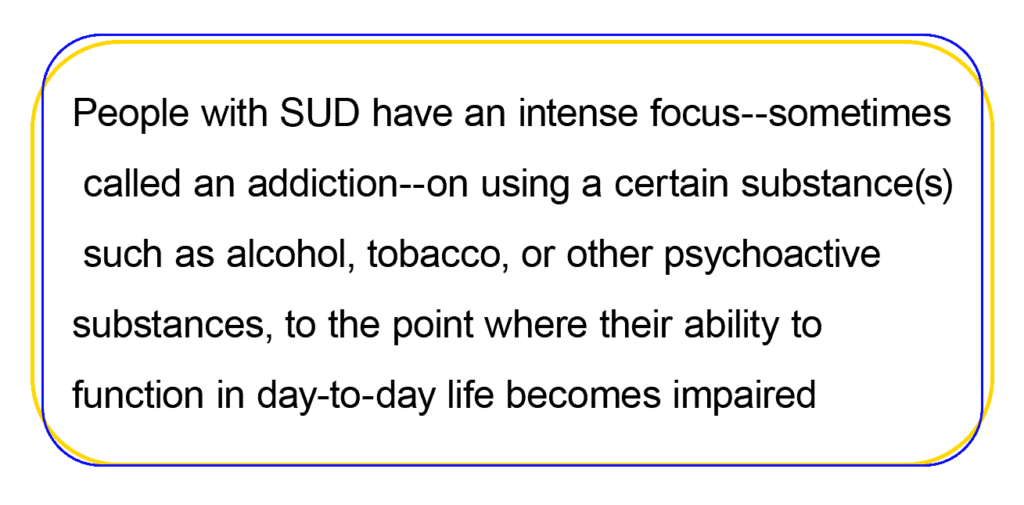In recent years, the terminology surrounding alcoholism and addiction has evolved significantly, reflecting a deeper understanding of these conditions. Previously, terms like “alcoholism” and “addiction” were commonly used, often carrying stigmatizing connotations and lacking specificity. The shift to using “substance use disorders” (SUDs) represents a more precise and medically accurate approach. This change aligns with the criteria outlined in the Diagnostic and Statistical Manual of Mental Disorders, Fifth Edition (DSM-5), which categorizes these conditions under various specific diagnoses, such as Alcohol Use Disorder (AUD), Opioid Use Disorder (OUD), and others. By adopting this language, healthcare professionals emphasize that these disorders are chronic diseases, similar to diabetes or hypertension, requiring appropriate medical treatment and intervention.
The change from using the term “addiction” to “substance use disorder” was primarily driven by advancements in medical and psychological research, as well as the efforts of leading health organizations. The American Psychiatric Association (APA) played a crucial role in this shift. In 2013, the APA published the fifth edition of the Diagnostic and Statistical Manual of Mental Disorders (DSM-5), which introduced “Substance Use Disorder” (SUD) as a comprehensive term that includes various substance-related conditions, such as Alcohol Use Disorder (AUD) and Opioid Use Disorder (OUD). This new terminology aimed to provide a more precise, clinical framework for diagnosing and treating these disorders.
In addition to the APA, other influential bodies like the National Institute on Drug Abuse (NIDA) and the World Health Organization (WHO) have supported and promoted the use of “substance use disorder.” These organizations recognized the importance of adopting language that reflects the complex nature of these conditions as chronic medical illnesses rather than moral failings or character flaws. This change in terminology has been part of a broader effort to reduce stigma, improve public understanding, and enhance the effectiveness of treatment and policy interventions for individuals affected by substance use disorders.
This shift in terminology also aims to reduce stigma and promote a more compassionate understanding of individuals affected by these conditions. Using specific terms like AUD or OUD helps to highlight the unique aspects and needs of each disorder, facilitating more targeted and effective treatment plans. Additionally, it underscores the idea that these disorders are part of a spectrum, recognizing varying levels of severity and the importance of personalized care. The change in language is part of a broader movement within the medical and public health communities to approach substance use disorders with a focus on health and recovery, rather than moral judgment or blame. This evolving terminology reflects ongoing advancements in the field and supports efforts to improve outcomes for individuals struggling with substance use disorders.
With a wide range of substances involved, each with unique characteristics and potential harms, the complexity of SUD presents significant challenges in prevention, diagnosis, and treatment. This comprehensive guide aims to demystify SUD, offering insights into its various facets, including the major substances involved, and the criteria used for diagnosis and determination of severity based on the Diagnostic and Statistical Manual of Mental Disorders, 5th Edition (DSM-5).

SUD is a complex, multifaceted issue that spans various types of substances, each with unique challenges in terms of prevention, diagnosis, and treatment. The standardization of SUD terminology and criteria, as stipulated by the DSM-5, allows for more precise diagnosis and treatment plans. However, more research, advocacy, and treatment options are needed to effectively address this pervasive public health issue.
It’s characterized by a pattern of continued substance use despite causing significant problems or distress, often resulting in health issues, disability, and failure to meet responsibilities at work, school, or home.

Several substances fall under the umbrella of SUD, each carrying distinct properties and impacts:
The Diagnostic and Statistical Manual of Mental Disorders, 5th Edition (DSM-5) provides standardized criteria for diagnosing SUD. It stipulates that the individual must exhibit a problematic pattern of substance use leading to clinically significant impairment or distress, as manifested by at least two of the following within a 12-month period:
The severity is determined as follows:
The onset of Substance Use Disorder (SUD) can be influenced by a variety of factors. Here are some notable ones:
Debunking common myths about SUD can combat stigma and promote understanding. For example:
The Impact on Society
SUD affects not just the individual and their family but also society at large:
Addiction Gap is a certified 501(c)(3) nonprofit
